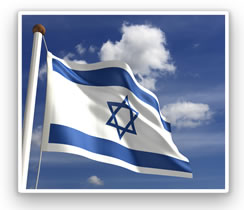

Information Related to "The Jews: From the Dispersion to the Modern Israeli State"
 | Audio/Video |
By the time the prophet Muhammad was preaching the tenets of the new Islamic religion, the Jews had not had a state for some five centuries.
They had rebelled against Roman rule in A.D. 66, a rebellion that took the Romans four years to crush. Thereafter, the Jerusalem temple lay in ruins.
 A later rebellion from 132 to 135 (the Bar-Kokhba revolt) led to the utter destruction of Jerusalem. The Romans built a new town on its ruins, renaming it Aelia Capitolina. No Jew was allowed to set foot there on pain of death. The Jewish nation-state was no more. It was not to exist again until the middle of the 20th century.
A later rebellion from 132 to 135 (the Bar-Kokhba revolt) led to the utter destruction of Jerusalem. The Romans built a new town on its ruins, renaming it Aelia Capitolina. No Jew was allowed to set foot there on pain of death. The Jewish nation-state was no more. It was not to exist again until the middle of the 20th century.
Following defeat in the two Jewish revolts, many of the surviving Jews fled Judea for other parts of the Roman Empire and beyond. From 638 to 1917 Jerusalem was under Islamic rule except for a short period during the Crusades.
Scattered throughout the nations, the Jewish people yearned to return to their homeland. Persecuted by governments and the Roman church, denied equal rights, frequently expelled from the new nations in which they had settled, the Jewish people's suffering continued down through the centuries.
Toward the end of the 19th century Jews began to return to their traditional homeland as the Zionist movement was born. Under the rule of the declining Ottoman Turks, the returning Jews joined other Jews who had remained in the area for centuries. They prospered and grew in number.
In 1917, after the defeat of the Ottoman Turks, the area came under the control of the British. In the same year, the British government announced the Balfour Declaration, named for the British foreign secretary Arthur Balfour, which promised Zionists a national homeland in Palestine. Meanwhile, encouraging Arab revolt against the Ottoman Turks who had sided with Germany in World War I, the British were making promises to the Arabs of independence, offering them their own homelands-two promises that would prove violently contradictory.
During the three decades of British rule, the Jewish population in the area continued to grow-and to be increasingly seen as a threat by the native Arab population. Clashes between the two ethnic groups became more and more frequent. Jewish resistance against British rule and unmanageable civil strife led to a British withdrawal and the division of Palestine by the United Nations. The 1947 UN-approved Resolution 181 called for partitioning the British-ruled Palestine Mandate into a Jewish state and an Arab state and for Jerusalem to be an international UN-administered city. The resolution was accepted by the Jews in Palestine, but rejected by the Arabs there and by all Arab states.
The Jewish nation of Israel was declared the evening of May 14-15, 1948, with a population of half a million. It was immediately attacked by armies from five Arab nations-Lebanon, Syria, Saudi Arabia, Jordan and Egypt. Israel triumphed, but decades of violence were to follow, with additional wars in 1956, 1967, 1973 and 1982. Arab resentment at Israel's existence remains unresolved, the Jewish state still insecure in a troubled, hostile region.
The majority of the Jewish people still reside outside the land of Israel-many living in the United States, Europe and Russia.
©1995-2022 United Church of God, an International AssociationRelated Information:
Sidebar to The Coming of Islam
Origin of article "The Jews: From the Dispersion to the Modern Israeli State"
Keywords: Jewish diaspora dispersion Jewish history Jewish homeland Balfour Declaration
Jewish history: